The extinction of military power and the era of tulips in the Ottoman Empire
Along with the land army, the Navy of the Russian Empire actively developed in 1730. Under Peter II, his development actually stopped. In 1728, the Swedish envoy denounced his government from Russia: “Despite the annual construction of the gallery, the Russian galley fleet is greatly reduced compared to the previous one; the ship's ship is falling into direct ruin because the old ships are all rotten, so that more than four or five ships of the line cannot be brought into the sea, and the construction of new ones has weakened. In the admiralty, such disregard is such that even in three years the fleet cannot be brought back to its former condition, but no one thinks about it. ”
Under the leadership of the new empress, everything changed. Already in July 1730, a decree was adopted in which "the Admiralty Collegiums were reaffirmed to the strongest extent, so that the naval and galley fleet were kept according to the charters, regulations and decrees, without weakening and not relying on the current prosperous peace time." In December 1731, a new 66-gun ship was laid at the Admiralty Shipyard. Then the Empress Anna Ioannovna ordered to renew on the Baltic navy regular exercises with access to the sea, in order to "have these things for people and ships real inspection, because in the harbor rigging and other damage can not be inspected as much as a ship in motion."
In 1732, a special commission was established, the purpose of which was to proclaim “bringing the proper, permanent and good order of the fleet, both ship and galley and admiralty, and everything that belongs to it”. Osterman became the Chairman of the Maritime Commission, and its members included experienced sailors, Rear Admirals T. Sanders, N. Senyavin, P. Bredal, V. Dmitriev-Mamonov and Count N. Golovin. The Commission decided to urgently resume the construction of large sailing ships in the Baltic. By 1736, the Baltic Fleet included 20 battleships, 17 frigates, 2 shnyavas, 2 bomber ships and 8 packbots. In addition, there was an independent and rather numerous Rowing Flotilla. For the entire reign of Anna Ioannovna, only for the Baltic Fleet they built about 100 warships, including 20 battleships and 10 frigates.
Under Anna Ioannovna, the Admiralty College, which led the naval forces, was also reformed. Instead of the former eleven offices in its structure, four expeditions were created, which greatly simplified the clerical work, reduced correspondence and improved monetary and material reporting. Reformed and staffing the fleet in general. All officers and sailors of the ship and galley fleet were consolidated in the 36 mouth. In addition to them, two naval regiments of twelve companies each were formed in 1733. In addition, a naval artillery corps, also consisting of twelve companies, appeared in 1734. The Dane P. von Haven, a witness of the reorganization of the fleet states, noted in his notes: “All sailors (of the galley fleet) received weapon, as soldiers, namely swords, guns and bagnets, and now they must, besides maritime affairs, also be trained in the military. This is clearly done in order to more successfully apply them in the flotilla against the Turks. The entire officer staff was also changed and arranged according to the English model in the best direction for the officers ... ". The naval service was very difficult, even in comparison with the army, so the nobles came to the Naval Academy, which trained the naval officers, reluctantly, especially after the opening of the Shlekhetny case. However, the majority of cadres were natural Russians.
With the aggravation of relations between Russia and Porto, Petersburg's interest in building ships on the Don and the Dnieper noticeably increased, since there was already a positive experience. In the spring of 1733, Vice-Admiral Zmayevich was sent to Don, who was instructed “with haste” to start building the 20 gallery, 23 bots and 400 Boudar (a small Cossack vessel, other names - dugout boat, odnodorivka, dolbuka, oak, etc. d.) In 1735-1736 these vessels, as they were manufactured, were concentrated in Pavlovsk and Tavrov and became part of the Don Flotilla. In January, 1738, on the initiative of Minikh on the Dnieper, Zaporozhye shipyard was founded on the island of Khortytsya.
Thus, during the rule of Anna Ioannov, the army and navy of Russia were considerably strengthened. The leadership of the Russian armed forces has become more centralized. Cuirassier regiments appeared in the cavalry. Were refined and improved the rules of engagement infantry. For the training of officers, the Noble Corps was opened, which marked the beginning of a century and a half stories cadet corps in Russia. The network of schools for soldiers' children has expanded. Shipbuilding was actually revived. True, Munnich imposed the Prussian training system, which boiled down to drill and increased the burden of service for the soldiers. However, in general, the armed forces of the Russian Empire seriously strengthened.
The extinction of military power and the era of tulips in the Ottoman Empire
The period of the reign of the Ottoman Sultan Ahmed III (1703 of 1730 year) served as a prologue to the war with Russia, historians have called the "era of tulips." Indeed, the Sultan himself and his associate Grand Vizier Nevsehirli Ibrahim Pasha, and behind them many representatives of the Turkish elite, loved these exquisite flowers, spent a lot of money on their purchase, and even made new varieties themselves. However, it was not only that. In Turkish, the word “tulip” sounds like “lala” and has a symbolic meaning due to the consonance with the word “Allah”. The reign of Ahmed III was a time when the Ottoman Empire struggled to defend its great power in a rapidly changing world and to preserve the results of its previous victories, its “tulip kiss”. The government of Ahmed III took measures to overcome the increasingly obvious backlog of the Ottoman Empire from the European powers and carried out a series of reforms.
True, the spending of the sultan and grandees on the construction of luxurious palaces and parks, the organization of amusements for a new, “European” mode, which in the “era of tulips”, became even more unrestrained, and the attempt to Westernize the Ottoman Empire (in many respects this process was similar to Westernization). Russia), which was the leading power of the Islamic world, could not return the empire its former power and glory. Westernization has somewhat updated the economy, the armed forces, the central apparatus, but in the end Turkey has increased its dependence on the West. Gradually, economics and finance fell under the full control of Western countries, and Turkey began to play the role of a battering ram in the fight against Russia, regularly exposing cannon fodder in the interests of England, France, and then Germany and Austria (World War I).
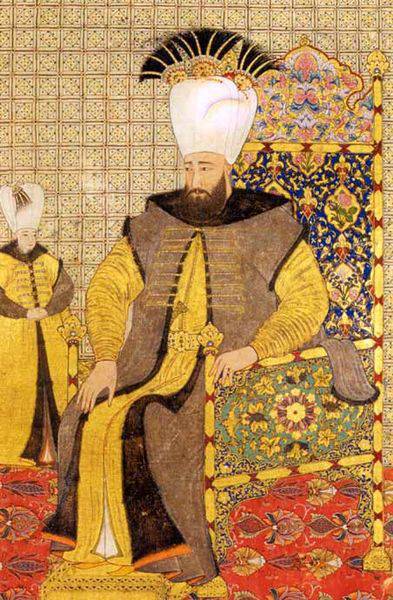
Sultan Ahmed III
The interest of the Turkish elite in the achievements of the West, primarily in the military, was associated with gradual internal degradation, which led to the loss of military superiority of the Ottoman Empire, formerly the leading military power in Europe. The Ottomans suffered a crushing defeat in the 1683-1698 war. Karlovitsky peace brought great territorial losses of the Ottoman Empire. Almost all the Hungarian lands belonging to Porte were ceded to Austria. The Austrians received Transylvania and almost all of Slavonia. Poland got part of the Turkish possessions in the Right-Bank Ukraine-Little Russia and Podolia. Morea left for Venice. Venetians also received a number of fortresses in Dalmatia and several islands of the Archipelago. Turkey has lost large revenues from these territories. The military prestige of Porta suffered enormous damage. The Ottoman Empire has ceased to be a thunderstorm for its European neighbors. Now it was considered as possible prey.
In 1714-1718 Porta fought with Venice and Austria. First, the Turks won up in the fight against the Venetians. But when Austria came out on the side of Venice, Porta began to suffer defeat. Austrian commander Yevgeny of Savoy beat the Ottomans several times in Hungary and Serbia. Austria occupied part of Serbia with Belgrade and some other territories. Under the diplomatic pressure of England and Holland, who feared the strengthening of Austria, Pozarevacky peace was concluded. Part of Serbia (including Belgrade), Banat, Northern Bosnia and part of Wallachia ceded to Austria. The Austrians received capitulation rights at the Port (advantages and privileges), similar to those that were previously acquired by the French and the British. True, Venice returned Porta Mora and a number of islands, but this was poor consolation for Istanbul. In addition, enterprising Venetians were able to achieve new benefits for their merchants.
Not successfully formed for the ports and the next war with Persia-Iran (1724-1736). Against the background of a weakened Safavid Iran, the Turkish elite hoped to gain revenge in the East after heavy defeats in the West. Turkish troops invaded the South Caucasus, seized Yerevan and Tbilisi. This almost led to a war with the Russian Empire, which at that time received the consent of the Shah of Persia to the cession of the western and southern shores of the Caspian Sea. In addition, Russia has long acted as a patron of the same Georgians and Armenians. However, Russia was exhausted by a long war with Sweden and did not dare to start a new war with Turkey. In the end, in the summer of 1724 in Constantinople, a Russian-Turkish agreement was concluded on the division of Persian possessions in the South Caucasus. In the port, the eastern regions of Georgia and Armenia, the Tabriz Kazvin and Shemakhi khanates, withdrew. Russia received Caspian cities and provinces.
After the signing of this agreement, the Ottoman troops launched an offensive in the western part of Persia and occupied Hamadan. In 1725, the Turks took Qazvin, then, after a heavy siege, Tabriz. In 1726, Persian troops recaptured the Ottomans on the outskirts of Isfahan. Under the 1727 agreement, Persia ceded the Ottoman Empire almost half of its territory. However, this success Porta was short-lived. The talented and cruel Persian commander Nadir, who became the de facto ruler of the country at the end of the 20, achieved a turning point in the war in favor of Persia. Nadir expelled the Ottomans from Hamadan, Kermanshah and South Azerbaijan. In 1734-1735 Persian troops occupied northern Azerbaijan, eastern Georgia and northern Armenia. Transcaucasia was devastated by a terrible war. Tens of thousands of civilians were killed and taken into slavery. Turkey was forced to make peace. In 1736, peace was made in Erzerum. Porta returned to Persia all the previously captured areas. The political and military prestige of Porta was again damaged. In addition, a long and unsuccessful war exhausted the finances of the state, caused a sharp increase in tax and other burdens on the population.
Not surprisingly, the Turkish elite began to look for ways to restore and strengthen the power of the Ottoman Empire, above all the military. First of all, the Ottomans had an interest in life and the achievements of the advanced for that time European powers. In 1720, at the behest of Sultan Ahmed III, an embassy led by ебelebi Mehmed Effendi was sent to France. The initiator of the embassy dispatch and the ambassador's mentor was Grand Vizier Ibrahim Pasha (he held this post in 1718-1730). Ibrahim was one of the first major Ottoman statesmen, who realized the need to break the prejudice barrier against all European, to begin seriously acquainted with the achievements of European countries in the organization of state and military affairs, in the development of science and technology. The ambassador was instructed to carefully review the economy, culture and science of France. The embassy stayed in France for two years. The members of the embassy studied the state system and the social and political life of France examined the companies and fortresses, visited a military review, visited the royal Academy and other institutions. Everything seen Mehmed Effendi outlined in the "Book of the Embassy." This work largely contributed to the emergence of the idea of "Europeanization" of the Ottoman state among the Turkish feudal-bureaucratic elite and gave impetus to the first changes. In fact, the Ottomans repeated the experience of the Embassy of the Russian Tsar Peter, who also began the fundamental westernization of Russia.
A Frenchman, Count Bonneval, who entered the Turkish service and accepted Islam, founded an artillery school in Istanbul. It was the first secular educational institution in Turkey where exact sciences were taught. A major event was the introduction of typography in Turkish. In 1727, the Sultan issued a decree on the opening of the first printing house. In Turkey, began to print books written by both Muslim and European authors. It was an extremely important event in the life of the Ottoman Empire, in the development of education, science and culture in general.
Ibrahim Pasha tried to streamline matters in the administrative apparatus of the Ottoman Empire, improve financial condition, increase the combat capability of the armed forces. The central authorities tried to streamline the tax system, attracted individual foreign military advisers, sought to create new artillery units, build new ships. But reformers had no clear program and goals, reforms were inconsistent, unsystematic. As a result, the reforms did not give any noticeable results then.
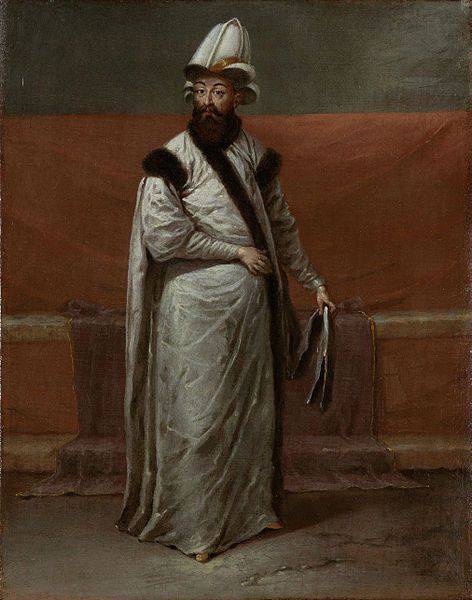
Grand Vizier Nevshehirli Damad Ibrahim Pasha
Moreover, dissatisfaction with conservative circles and citizens, irritated by high taxes and corruption, led to the uprising of the population of Constantinople. The immediate cause of the uprising was a military defeat in the war with Persia. News of lesions 1729-1730. became an occasion to revolt. The ground for the uprising was prepared by the corruption of the regime. The Russian resident in Constantinople, I. I. Neplyuev, noted in his reports: “Sultan Agmet ... from the beginning of his state until the end was defeated by the insatiable passion of avarice. For the pleasure of that, his ministers, leaving the truth and the court, with money of all sorts and attacks from their subjects, abducted money and executed saltan non-content. For which the people of Turkey and all sorts of subjects from excessive re-imposed duties and vain attacks in considerable bitterness were grumbling about the liars of Saltan and ministerial multiplied. "
The discontent of the inhabitants of Constantinople with the sharp deterioration of their situation was fueled by the annoyance that they had caused by unbridled luxury and insane spending of the sultan's court, lush celebrations and entertainment of the elite during the war, when the whole country was in poverty. Historians Mehmed Rashid Efendi and Ismail Asym Efendi later wrote: “... the anger of the people only intensified and soon turned into riots; despite the financial difficulties in the country, festivities were held day and night, and when the holidays ended the Grand Vizier and the Sultan went to the garden of the Davutpasha Palace to listen to the nightingale singing. ” The historian Shem'dana-zadeh wrote about Ibrahim Pasha: “... a waster and mot, he has fun day and night, deceiving the people with inventions installed on the days of holidays in squares: cradles, carousels, swings; thereby mixing men and women, clouding their minds with false songs. ” It is clear that the political opponents of the Vizier, dissatisfied with his policies, took advantage of the people's discontent.
At the end of September 1730, the population of the capital of the empire was agitated by the news of the surrender of Tabriz and the military riot in Erzerum, which the retreating forces had raised. This heated the situation in the capital to the extreme. The uprising of artisans and the urban poor began. They were joined by janissaries who were active participants in the urban trade and handicraft industry and also suffered extraordinary military taxes. Janissary headed Patron Khalil, Albanian by origin. In the evening of September 29, the rebels captured Tersane - a naval arsenal. Then the main janissary units, which had been waiting for two days, joined the rebels, and their total number increased to 60 thousand people.
This forced the Sultan to begin negotiations. 30 September, the rebels released prisoners from prison. In the evening, the rebels blocked the Sultan's palace. Ahmed tried to save his throne and ordered the execution of Vizier Ibrahim and several dignitaries who caused the particular hatred of the rebels. However, this did not save him. On the night of October 2, the Sultan was forced to cede the throne to his nephew. New Sultan Mahmoud I soon restored order. To reassure the people, the Sultan vowed to abolish new taxes and eliminate surcharges to ordinary taxes. Many rebels received high positions. Khalil himself entered the sofa (the highest authority). At the same time, the Sultan was actively preparing for a retaliatory strike. He used the tried and tested method of bribing. Mahmud was supported by the Crimean Khan, the new Vizier, the mufti and officers of the Janissaries, dissatisfied with the elevation of Patron Khalil. As a result of the influence of the Muslim clergy, the ranks of the rebels were greatly reduced.
In November, Patron Khalil and other leaders were killed by order of Mahmoud I right at a meeting of the high council. Their bodies were thrown into the sea. Many activists of the uprising were arrested and exiled. Then began the hunt for the rebels. In three days, more than 7 thousand people were killed. However, the survivors and their comrades attempted revenge. The uprising that followed in March 1731 was drowned in blood.
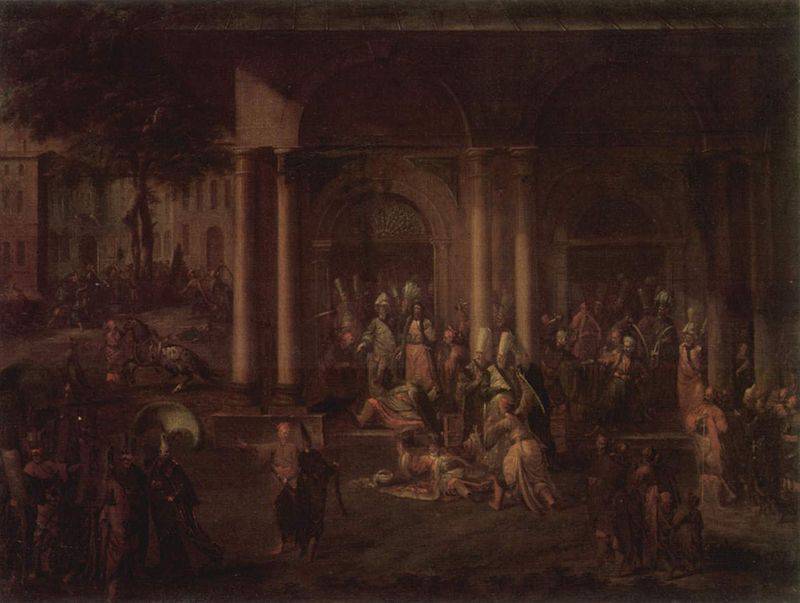
Rise of Patron of Khalil. Jean-Baptiste van Moore
Turkish Army Reform Projects
Military affairs Ahmed III attached particular importance. The first projects for the reorganization of the Ottoman army appeared before the Sultan even before his appointment as Nevsehirli Ibrahim Pasha as a vizier. At the end of 1710, the Austrian envoy in Constantinople, von Thalmann, informed his government that a certain Pole Stanislav Poniatowski, through the French ambassador, Count Dezaleier, presented the project to Baltija Mehmed Pasha, the visitor, "how to make Turkish troops regular and invincible in a short time."
The next draft of the military reform was proposed to the Ottomans by the Hungarian prince Ferenc Rakoczy, the head of the anti-Habsburg uprising of 1703-1711, which caused particular concerns in Vienna. It was proposed to form a regular corps of Christian soldiers and Muslims under the command of the prince. Rakoczy accepted the offer and moved to Turkey in 1717. But the plan was not implemented. Then, on the orders of Ibrahim Nevsehirli, another treatise was drawn up on the need for military reforms. Some researchers attribute the text of Rakoczi, others - to a native of Transylvania, the founder of the first Turkish printing press Ibrahim Myteferrik.
At the end of 1717, French military engineer Rochefort arrived in Constantinople. He established contacts with Ibrahim Nevsehirli and proposed to resettle the French Huguenots to Turkey, and then create a corps of military engineers under the Turkish army. Rochefort's projects, however, were not implemented, either because of pressure from France, or because of dissatisfaction with the janissaries, who did not want to serve with "jaurami" ("infidel"). In 1720, Rákóczi proposed to Porte to create a regular corps of Hungarians, Albanians and Zaporizhzhya Cossacks. Vizier Ibrahim Pasha himself was an ardent supporter of reforming the army according to the European model. In a report to Ahmed III in 1718, he wrote: “The condition of our troops is known, even if the enemy has ten thousand people, one hundred thousand of our soldiers cannot resist them and flee.”
In 1730, the Frenchman Alexander Claude Bonneval, who had served in the Austrian army, tried to move things from a dead end, but because of a conflict with the Viennese authorities, he left the service and offered his services to Vizier Ibrahim Pasha. After the death of the vizier, Bonneval (who converted to Islam and took the name of Ahmed Pasha) was under Rakoczy for some time, and at the beginning of 1732 was again in demand by the government. By order of the new vizier, Topal Osman-Pasha, he took the post of chief artillery commander and proceeded to reorganize the bombardier corps according to the European model. In 1732-1735 the artillery school recruited people who were trained by Europeans (mostly French, who converted to Islam). However, the first graduates died in the war with Russia and Austria and the school was closed after some time.
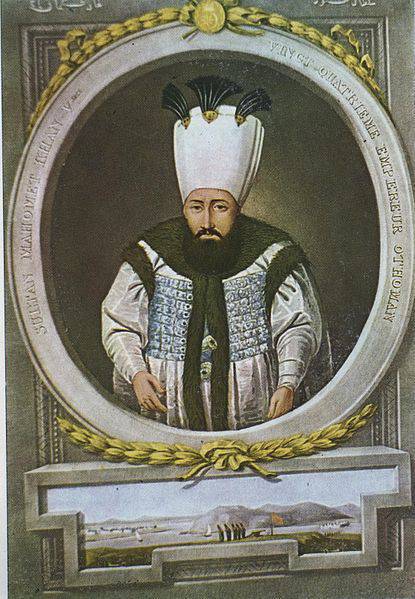
Sultan Mahmoud I
Thus, under the leadership of Ahmed III, all the projects to create a regular army remained projects. The main reason for this is the fierce resistance of the Janissaries and the clergy. The Janissaries cherished their privileged position and were ready to defend it in arms. The janissaries themselves, as, indeed, the sipahi (Turkish heavy cavalry), categorically refused to learn new fighting techniques. Because of this, military affairs in the Ottoman Empire stalled at the level of the XV-XVI centuries. Before the battle, the Ottoman army usually stood in three lines: in front of the cavalry, behind it the infantry, and behind all the artillery. The cavalry was divided into separate groups of uncertain composition and size. The favorite method of the Turkish cavalry was to force the enemy to focus on one flank with a false attack, and then strike at the other, crush the enemy's line. The infantry was very mobile and only supported the cavalry, taking up defensive positions. During the defense, the infantry beat off the onslaught of the enemy, giving the cavalry the opportunity to regroup and counterattack. In general, the Ottomans preferred to attack, having a numerical superiority, sought to achieve success with a quick attack, crush the first rows of the enemy and develop the offensive. However, with the stubborn resistance of the enemy lost morale, also quickly retreated.
At the beginning of the XVIII century. Corps Janissaries have lost their former combat capability. The recruitment system of the Janissary Corps Devshirme (“blood tax”) was often violated. The children of merchants, minor Muslim officials who sought to enter a privileged corporation penetrated the janissaries. A lot of outsiders and simply “dead souls” were added to the corps lists for salary. Great salary, privileges, generous gifts of the sultans, the opportunity to advance to high military posts, all this made the Janissaries a closed caste, which fiercely defended their rights. The janissary corps met any attempts on its privileges with a fierce rebuff and soon turned into a support for the sultan's throne, and a threat for those rulers who treated them without due respect. It is no coincidence that in the XVII - XVIII centuries. There are many examples of Janissary rebellions, which many sultans have become victims of.
Another major component of the Ottoman army, the sipahi, also degenerated. The equestrian militia, which consisted of the owners of the military lens, who had been granted military service, fell into disrepair. For several centuries, the composition of landowners has changed qualitatively. Since the end of the 16th century, the ban on the concentration of several flaxes in the same hands was no longer observed. There were extensive estates, the owners of which arbitrarily increased the duties of the peasants and were not interested in military affairs. The patriarchal feudal lord, who was primarily interested in the war and military booty, replaced the far more stingy landowner, who sought to squeeze the maximum income out of the peasants and diligently avoided military service. By hook or by crook, the civilians, merchants and usurers acquired the flax. Many bipahi nobles, on the contrary, went bankrupt. In the middle of the XVII century. Kochi-Bey, a writer, noted with indignation that if earlier "villages and arable fields were in the hands of men of sabers and sons of the hearth," now they are seized by "every bastard."
It is clear that this led to the fall of the military power of the state. Sipahi cavalry decreased quantitatively and deteriorated sharply in quality and combat capability. While under Sultan Suleiman the Magnificent, the sipahi numbered over two hundred thousand people, then at the turn of the XVII-XVIII centuries, their numbers, according to Count Marcilla, who visited Turkey, were a little over fifteen thousand. Cavalry training sharply deteriorated. A contemporary of Marsilia, the English diplomat Paul Rico (1628-1700) noted in his book on Turkey that in a sipahi battle "nothing but an embarrassed multitude of people." A similar assessment is given by Dubrovchan S. Gradich: “Previously distinguished by belligerence, strength, patience, modesty, temperance and frugality, now they (sipahs) have become sluggish, cowardly, voluptuous ...”.
Moreover, already in the 17th century, the barns constantly participated in unrest and revolts, which shook the empire from the inside. To combat them, the Ottoman government increasingly used the Janissaries, falling from them into even greater dependence. The Ottoman Empire also had many different irregular militias, but their combat effectiveness was even lower. They were mostly “distinguished” by robberies and massacres of civilians.
Thus, by the beginning of the war with the Russian Empire, Turkey was not in the best condition. She lost internal unity and strength, suffered a series of defeats from the neighboring powers. The core of the army, the janissaries and sipahi, was at the stage of decomposition. The necessary reforms could not be carried out due to the lack of a clear goal and program, as well as the resistance of the conservative part of the elite and society. However, the Port was still a powerful regional power with a huge mobilization potential. Turkey was able to put up a large army and controlled vast territories in Asia, Africa and Europe. The Ottoman fleet hosted the Black Sea and had a strong position in the Mediterranean.
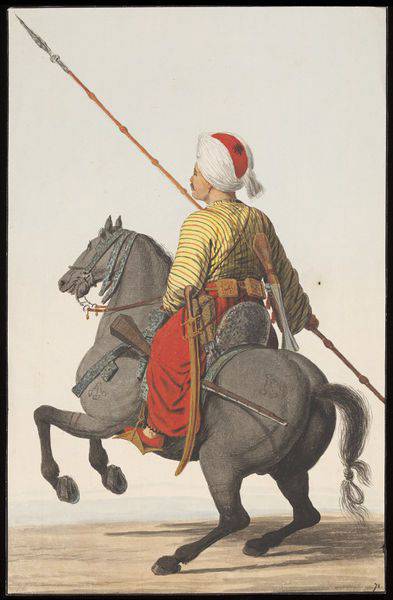
Sipah
To be continued ...
Information